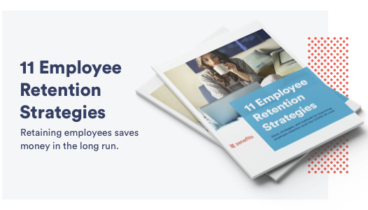Here’s how you can retain employees who seem to be determined to look for greener pastures elsewhere.

Here's what you need to know:
-
Employee surveys can help you understand why your employees are unhappy
-
Certain industries are more prone to high turnover, including entertainment and hospitality
-
There are 4 basic steps you can take to help retain key talent
There seems to be anecdotal data, or at least conversations, everywhere saying that employee turnover is at an all-time high. All of this noise begs the question: is it true? Do your employees want to quit and jump ship for what they perceive as greener pastures?
The answer isn’t precisely binary — it’s actually yes and no. Keep reading to find out what the facts really are and what you can influence to turn the tides in your organization.
Survey says: Yes, your employees want to quit
The basic fact is that at any given point in time, some of your employees are considering making a move for 1 of 5 consistent reasons:
- Advancing their career prospects
- Experiencing a different work culture
- Having more flexibility
- Increasing their income
- Receiving better benefits
PwC’s US Pulse Survey confirms that these are the main reasons people choose to make a professional move. You may be thinking that there isn’t anything earth-shattering about that list. And you’d generally be correct. That is unless it’s your employee that’s motivated to leave for one of those reasons.
However, according to the September 2021 numbers on the Bureau of Labor and Statistics Turnover Report, the average percentage of employees who are planning on leaving their current position is up from the same time last year by 0.5%.
More than 800,000 U.S. employees in 2021 planned on leaving their positions.
That may not seem like much when you consider an increase to 4.2% in 2021 from 3.7% in 2020. But when you stop and consider that half of a percent represents nearly 806,770 employees in the U.S. workforce, it becomes a bit more eye-opening.
Are certain industries in more danger than others?
Between increasing minimum wages and strict health guidelines, the hospitality industry has been hit hard over the past few years. Still, they’re not the only industry that is experiencing turnover. Think also about:
- Arts and entertainment
- Construction
- Professional and business services
- Recreation
- Retail
- Trades and utilities
- Transportation
When you think about this list, there isn’t a single industry in the entire workforce that isn’t represented in one way or another. Even so, 3 of these industries have experienced over 100% turnover:
- Arts and entertainment
- Hospitality and food services
- Recreation
Maybe you have been experiencing the headache of that constant revolving door. Is there anything you can do to slow the turnover rate?
You can’t control someone’s desire to quit, but you can try to address the reason why.
You can’t control your employees’ desire to move to a different opportunity. Still, you can provide an environment that makes it a more difficult choice for them.
There are 4 basic steps you can take to create a stronger environment that will retain your vital employees.
Identify your strong performers
Sometimes people move on, and it’s actually best both for the employee and your organization. Other times, though, you have employees that make the company a much better place. Those are the people you want to retain. Don’t let them get lost in the shuffle of the chaos of the daily grind.
- Offer honest feedback. These top performers want to continue to improve. Give them positive feedback and also constructive words that can help them improve.
- Make sure their pay reflects their value to the company.Whether you offer higher base pay, performance bonuses, or a combination of the two, let your top performers know you value them through their income. Employees check various salary reports to keep track of whether or not they’re being paid a fair wage. Your top performers should be paid higher.
- Offer perks. Sometimes, extra paid time off speaks volumes. Encouraging your top performers to take time to recharge and recuperate allows them to return refreshed and better able to contribute to the company.
Offer competitive pay to keep employees wanting to quit
Start from a position of strength. You don’t want your company to be the lowest paying company in the region. That’s a sure-fire way to ensure you have a high turnover rate. You generally don’t want to be the highest-paying company in the area, either. Paying top wages will only keep employees motivated for a while.
It seems counterintuitive, but, in time, paying at the top of the industry actually results in a feeling of entitlement and discontent among your staff. It also doesn’t give you a way to differentiate the pay for your top performers.
It can cost about 6 to 9 months of an employee’s annual salary to get their replacement hired and trained.
If you experience a bit of angst when you think about paying in the middle or even toward the higher-end (not at the top) of the market for your industry, put it in the context of the high cost of turnover. According to an SHRM (Society for Human Resources Management) study, it can cost anywhere from the equivalent of 6-9 months (50%-75%) of an employee’s annual salary to get their replacement hired, onboarded, and up to speed.
This doesn’t include the amount of organizational intellectual capital that was lost when that employee walked out of the door. Here are the simple numbers:
- Employee’s salary: $50,000 per year
- 3-months to replace the employee and get the replacement onboarded: $12,500
- 6-months lost productivity: $25,000
- Total annualized cost for that position that year: $87,500
You’re an intelligent manager, so you’ve budgeted for turnover, but it would sure be nice to be able to use that $37,500 somewhere else on your bottom line.
Offer valuable benefits
Benefits are a strong motivator for many employees. Yes, this means paying part of, or all of, their health insurance, but it also includes ancillary items such as:
- Paid time off
- Matching contributions to a 401(k)
- Paid volunteer time
- Paid parking (you wouldn’t believe how many wins this gets a company)
When employees want to quit, take time to ask what’s important to them
The fastest distance between two points is a straight line. There are two ways to handle finding out what matters to your staff:
- If you have a strong relationship with your employees and there is mutual trust, you can sit down and ask them what they would define as a great work environment and what that means to them.
- If, on the other hand, you want to get as unbiased of a result as possible, you can arrange for an anonymous third-party survey. This will get you results that may be less skewed by an employee’s concern of saying something less than stellar to the boss.
Regardless of which route you choose, use part of your staff meeting time to create open conversations about various topics so employees can feel safe about offering ideas without concern about how their contributions will be received.
Final thoughts: When employees want to quit
Whether there is actually a lot of turnover happening or if it is more fiction than fact, you have the ability to create a healthy environment that will result in a satisfied workforce. Turnover will always happen, but you can influence whether it is a debilitating factor for your company or not.







